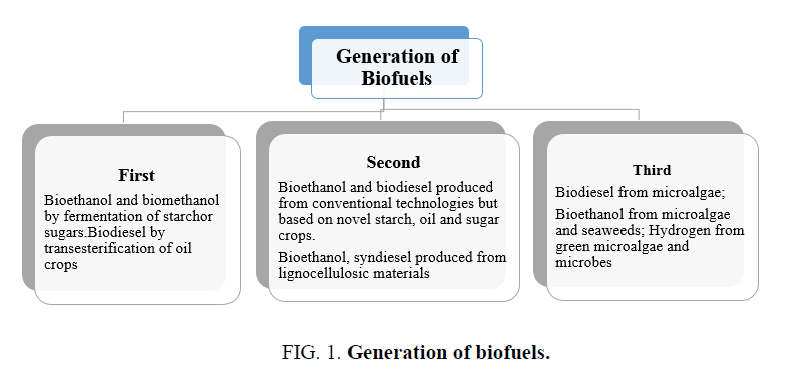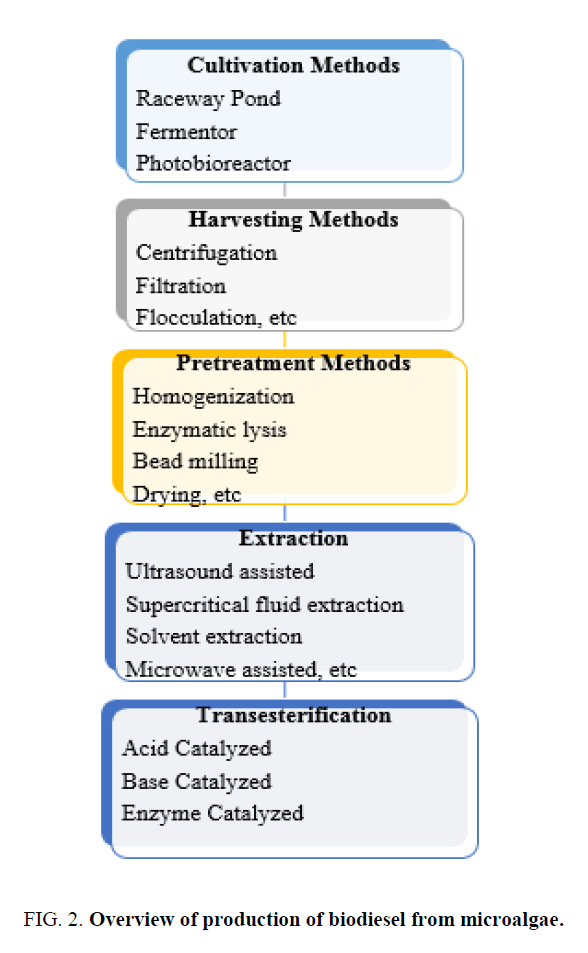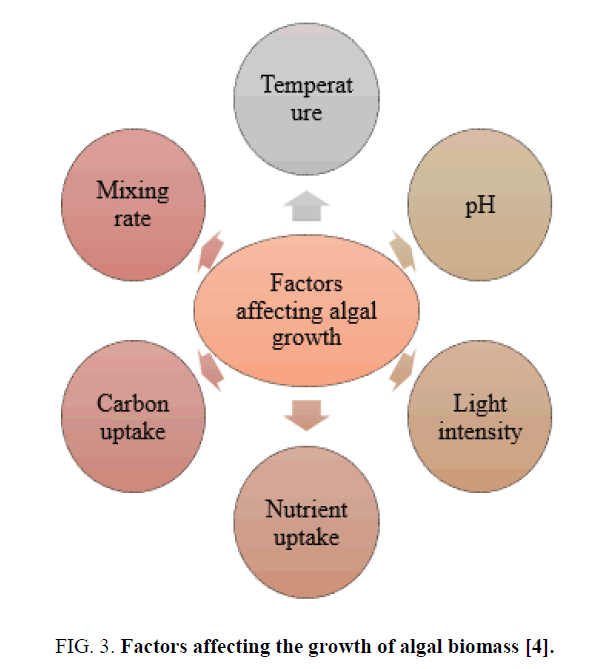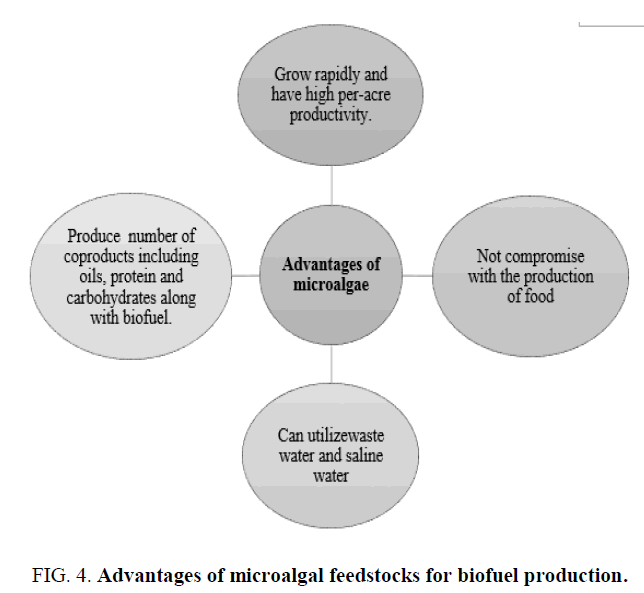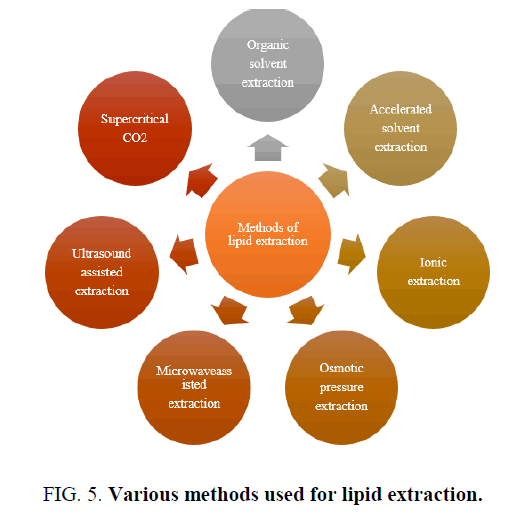Original Article
, Volume: 12( 3)A Review on Harvesting and Lipid Extraction Methods for Biodiesel Production from Microalgae
- *Correspondence:
- Arpita Roy, Department of Biotechnology, Delhi Technological University, New Delhi, India, Tel: (+98)-71-32424127; E-mail: arbt2014@gmail.com
Received: October 10, 2017; Accepted: October 29, 2017; Published: November 02, 2017
Citation: Arpita Roy. A Review on Harvesting and Lipid Extraction Methods for Biodiesel Production from Microalgae. Res Rev Biosci. 2017;12(3):134
Abstract
Search for an alternative to the fossil fuels continuously grows; microalgae have emerged as a promising renewable feedstock for biodiesel. Many species contain high concentration of lipids and require simple cultivation methods than traditional crops for the production of biofuels. Microalgae have the ability to produce number of biofuels such as bioethanol, biodiesel, bio-hydrogen, etc. Production of biofuels from microalgae is considered as a potential process to meet the demand of future energy as microalgae can be cultivated year by year. But biofuels such as biodiesel production from microalgae comprised of several steps which includes various methods of harvesting and lipid extraction. This review provides an overview of production of biodiesel from microalgae, factors affecting the growth of algal biomass, various harvesting methods utilized for microalgae and lipid extraction methods for the production of biodiesel.
Keywords
Microalgae; Biodiesel; Physiology; Transporter; Plant
Introduction
Energy is the most important component of our life and it mainly comes from the renewable and non-renewable sources. The major portion of non-renewable energy comes from fossil fuels such as petrol, diesel and gas. These fossil fuels are produced by the process of millions of years. But due to uncontrolled utilization of these fossil fuels, a threat of their depletion is growing day by day. Also burning of this fossil fuel causes several problems such as high carbon dioxide emission to environment as well as green-house effect. Due to such problems there is a requirement an alternative renewable source of energy. Biofuels is renewable sources of energy which include solar, hydro, wind, bio-energy, etc. [1,2]. Bioenergy is a type of energy which has huge potential as it comes from the biomass which is available in a huge amount as well as it can be regenerated year by year. Biomasses which are utilized for energy production are termed as feedstock of biofuels and there are several generations of biofuels. First generation biofuels include bioethanol which is derived from sugar based crops such as maize, sugarcane, etc. But sugarcane and maize were itself food crops so their use as a fuel was highly criticized. This led us to generate second generation biofuels such as bio-ethanol from ligno-cellulosic feed stock and biodiesel from non-edible oil based crops such as Jatropha. Still there are lot of complications with second generation biofuels such as long-time degradation of cellulosic material in case of ligno-cellulosic fuels and huge requirement of land for Jatropha [3]. These critical situations forced us to move to third generation biofuels i.e. biofuels from microalgae Figure 1.
Microalgae have been found most suitable among all possible potential feedstocks [4]. Algae are photosynthetic, prokaryotic or eukaryotic and micro or macro-organisms. Prokaryotic algae include Cyanobacteria (blue green algae) while eukaryotic algae include green algae and diatoms [5,6]. Algae have been classified in four different groups i.e. Bacillariophyceae (Diatoms), Chlorophyceae (green algae), Cyanophyceae (blue green algae) and Chrysophyceae (golden algae). There are 1, 00, 000 known species of Bacillariophyceae and mainly found in ocean, fresh and brackish water. Chyrsolaminarin and TAG are the storage material of these algae. Green algae are found in fresh water and there are approximately 8, 000 species of green algae. Starch and TAGs are the main storage material in green algae. Blue green algae are very diverse in their habitat. There are around 2000 species in this group. They are similar to green algae as they also have storage material like starch and TAGs. Golden algae are mainly fresh water algae having carbohydrate and TAGs as storage material. This is the smallest group of microalgae as they have approximately 1000 species. Some of algae are very much utilized for health food, feed and pharmaceuticals. Due to this feature of such algae, biofuels production can be clubbed with the production of such other commercial products. This can make the process economically more viable. For example, Chlorella sp. have been cultivated as alternative and unconventional protein sources [7], also contains proteins, carotenoids, lipids, immuno-stimulator, polysaccharides, vitamins, antioxidants and minerals [8], antimicrobial effects etc. [9]. The residue that remains after the production of biodiesel can be utilized for the production of other biofuels, fertilizers, animal feed etc. [10]. Algae can also be utilized for the production of other high value products simultaneously with the production of biofuels which again make the production process cost effective [5,6]. Production and downstream process of biofuels incurred huge cost [11]. Cost of biodiesel production depends upon factors like feedstock, plant capacity and location of the plant, plant design and equipment. Biodiesel production from the rapeseed or soya oil increases the production cost due to the expensive feedstock.
Utilization of non-edible feedstock like jatropha oil reduces feedstock cost. Economic analysis of biodiesel production from Jatropha revealed that production of cost of jatropha ethyl ester to be 0.40 € per litre [12] whereas 0.57 € per litre in case of palm oil is 0.57 € per litre [13]. Utilization of non-edible oil for production of biodiesel reduces the production cost it has major drawbacks such as Jatropha plant takes 2-3 years to grow and produce seeds which prevent the industry to flourish. Due to these problems microalgae have various advantages over other terrestrial crops make them an interesting perspective for the future Figure 2 to 5.
Figure 2: Overview of production of biodiesel from microalgae.
Figure 4: Advantages of microalgal feedstocks for biofuel production.
Experimental Methods
Harvesting methods
Harvesting of biomass is basically the separation of biomass from the culture medium. 20%-30% expenditure was recorded due to harvesting process [4,14] but in some cases, it was increased up to 50% [15] and up to 90% [16]. The challenges of harvesting include the small size of the microalgae cells [17], similarity in the density of the algae cells and the medium [18], formation of stable suspensions due to presence of negative charge on the surface of algae cell [19,20] requirement of frequent harvesting of biomass due to high growth rate [21]. To cope-up these challenges, several different methods have been tested for the harvesting of algae biomass [17,22,23].
Sedimentation: Sedimentation is the process in which the liquid or solid particles are separated from the liquid medium (with different density) with the help of gravitational force [21]. It has been found that a common round shaped alga, Chlorella has achieved a settlement velocity of 0.1 m/day in fresh water. But there was reported a huge difference in the settlement rate [18] as it depends on factors such as type of microalgae [24], light intensity [25], nutrient deficiency and age of cell [26]. Therefore, harvesting of algae biomass is not widely done by sedimentation. The recovery of harvesting was also low i.e. 60%-65% of biomass [4,23].
Flocculation: Flocculation is the aggregation of micro algae cells by the use of flocculating agents. It increases the rate of sedimentation [4]. Flocculation is considered as most reliable but expansive [27] method. Flocculation has been divided in to two types i.e. auto-flocculation and induced flocculation. Due to various environmental factors such as stress, changes in nitrogen, pH and dissolved oxygen [28], the cells of microalgae get flocculated. But it is a slow and unreliable process. Flocculation may be induced chemically, biologically or physically. The flocculants should be less expensive, non-toxic, highly effective in low concentration [17], derived from non-fossil fuel, sustainable and renewable source. Chemical fslocculants may be organic or inorganic. Inorganic flocculants include lime, ferric chloride, ferric sulfate and aluminum chloride (alum). In case of Chlorella and Scenedesmus, alum has been found more effective flocculent [17]. 1 g/l concentration of inorganic flocculent was found appropriate by [29]. These inorganic flocculent can be toxic which can damage algal biomass [17,29]. But the cost of these inorganic flocculent is less in comparison to organic one. So, some new inorganic flocculent must be tested which don’t have any adverse effect [21]. Organic flocculants such as cationic poly-electrolytes (CPE) provides 35 times higher results at the concentration of 2 mg/l-25 mg/l. Chitosan is renewable organic flocculants derived from crustacean shells and used for treating food industry wastewater [30]. It is a non-toxic in nature, but its dosage is very high at the range of 20 mg/l-150 mg/l [17,30]. Starch and modified starch are another category of flocculent that is utilized for harvesting of micro algae [31]. These modified starches can be utilized more effectively than both inorganic and synthetic organic flocculants, but they are costly [32]. Microorganism such as bacteria can be utilized as flocculent [33] and also reported in case of Chlorella [17] and Pleurochrysis carterae but they need a good amount of carbon source to grow which made this process less cost effective. Therefore, there is no single or universal flocculent that can be utilized for the harvesting of all type of microalgae although flocculation is a potential method of harvesting as the input of energy is very less [21].
Flotation: Flotation is commercially done by introducing the air bubbles in the culture. Flotation may be classified [33] as dissolved air flotation, electrolytic flotation and dispersed air flotation. Sparger is used for the preparation of bubbles at gas pressure of 3 atmospheres [34]. The range of size of bubbles is 10 to 100 micrometers [19]. But high energy is required for small bubble production which is large in comparison to centrifugation that made this process less economic [31].
Filtration: At a very large scale, filtration gives satisfactory results [17]. The filters used in the filtration process have a range and can be classified according to pore size as macro filtration (>10 μm), micro filtration (0.1-10 μm), ultra-filtration (0.02-0.2 μm), reverse osmosis (is less economic than centrifugation at commercial scale [17]. Ultra-filtration is used for fragile cells and microalgae can’t be processed with it as the operating and maintenance costs are very high [4,17]. Filter press is also a good method of filtration. Filter presses has several advantages such as simple design, flexibility and capability to handle a wide range of slurries and equipment is relatively cheap. But the labor costs can be high [35,36]. Rotary vacuum filters with simple filter design are utilized for filtration of large micro algae but are not effective for smaller species [35,36]. It has also been concluded by two extensive reviews [17,37] that filtration is good for large cells of algae but not very effective for cells with diameter of less than 10 micrometers.
Centrifugation: In centrifugation, gravity is replaced as the force driving separation at a much greater rate. Almost all types of micro algae can be separated reliably and without difficulty by centrifugation [31]. Disc stacking centrifuges are the most common industrial centrifuge and are widely used in commercial plants for high value algal products and in algal biofuels pilot plants [17]. They are ideally suited for separating particle of the size (3 to 30 micrometer) and concentration (0.02%-0.05%) of the algal cells in a growth medium. They can separate solid/liquid, liquid/liquid or liquid/solid on a continuous basis. Disc stacking centrifuges generally have high energy consumption [37].
Lipid extraction methods
Two types of lipids i.e. polar and non-polar lipids have been present in algae. Phospholipids and glycolipid are major polar lipids while non-polar lipids include mono, di and tri-acylglycerides and carotenoids [15]. A detailed comparative study has been done by [38] on Tetraselmis sp. (Strain M8) by using different types of lipid extraction methods. They have performed their work in two approaches.
In first approach, Soxhlet extraction has been performed using single solvent Hexane (52 ml) and mixture of Hexane and ethanol (39 ml+13 ml) and further fatty acid analysis was done with GC-MS.
In second approach, different methods such as Bligh and Dyer method (Chloroform: Methanol) [39], Cequier-Sanchez method (Dichloromethane: Methanol) [40], Schlechtriem method (Propan-2-ol: Hexane) [41], Direct Saponification (Ethanol: KOH) [42] and super Critical CO2 [43] were tested. In terms of lipid yield, the order of extraction efficiency on Tetraselmis sp. was found as Dichloromethane: Methanol>Propan-2-ol: Hexane>Chloroform: Methanol>ScCO2>Ethanol: KOH. But this result differs in different algae [44,45] due to the differences in size and in particular cell wall composition.
Extraction of lipid from microalgae is dependent on the method by which the micro algae cell is disrupted and the type of solvent of mixture of solvent is [38].
Results and Discussion
After extracting the lipid from microalgae, it is necessary to characterize the lipid so that the further conversion of lipid into oil may be done accordingly. Various parameters of lipid are being characterized. Density (mass per unit volume) is measured by density meter via ASTM D4052. Specific gravity is the ratio of density of a substance with the reference and it is measured by density meter via ASTM D4052. API Density also measured by density meter via ASTM D4052. Viscosity refers to a fluid’s resistance at a given temperature. The kinematic viscosity is the ratio of the dynamic viscosity (μ) to the density of the fluid and measured by Kinematic viscometer via ASTM D 446-12. Acid value is number of mg of KOH required to neutralize one gram of oil or fat and measured via AOCS Cd 3d-63. Free Fatty acid content (% FFA) value reflects the age and quality of oil and calculated via acid value. Iodine number measures the unsaturation of the lipid and constant for a particular lipid. It is measured via AOCS Cd 1-25. Saponification number is the amount of alkali (mg) required to saponify 1 g of oil and it reflects the fatty acid chain length and measured via AOCS Cd 3-25. Ester value is calculated via saponification value. Percentage of glycerol is determined from ester value.
Different method of lipid extraction process differs in their energy consumption, safety, efficiency and other parameters that need to be considered when selecting the best extraction method for a particular system [46-50].
Conclusion
Microalgae have the ability for the production of biofuels because they are able to capture and convert the CO2 into algal biomass by photosynthesis at much higher rates than other crops which are utilized responsible for conventional biofuels production. Biodiesel produce from the microalgae can potentially solve the problem based on current petroleum-based transportation fuels. Production of biofuels from microalgae involves various steps. Each step includes several methods. The present review discusses the role of microalgae on the biodiesel production and utilization of various methods for the harvesting of algal biomass. Further it also discussed the lipid extraction methods used for algal biomass.
References
- Dewulf J, Van LH. Renewables-based technology: Sustainability assessment. John Wiley & Sons Ltd. 2006.
- Gilbert R, Perl A. Transport revolutions: Moving people and freight without oil. Earthscan. 2008.
- Scarlat N, Dallemand JF, Pinilla FG. Impact on agricultural land resources of biofuels production and use in the European Union. In: Bioenergy: Challenges and opportunities. International Conference and Exhibition on Bioenergy. 2008.
- Mata TM, Martins AA, Caetano NS. Microalgae for biodiesel production and other applications: A review. Renewable and Sustainable Energy Reviews. 2010;14:217-32.
- Li Y, Horsman M, Wu N, et al. Biofuels from microalgae. Biotechnology Progress. 2008;24:815-20.
- Li Y, Wang B, Wu N, et al. Effect of nitrogen sources on cell growth and lipid production of Neochloris oleoabundans. Applied Micobiology and Biotechnology. 2008;81:629-36.
- Cornet JF. Le Technoscope: les photobioréacteurs. Biofutur. 1998;176:1-10.
- Mohan N, Rao PH, Kumar RR, et al. Studies on mass cultivation of Chlorella vulgaris and effective harvesting of biomass by low cost methods. 2009.
- Gors M, Schumann R, Hepperle D, et al. Quality analysis of commercial Chlorella products used as dietary supplement in human nutrition. J Appl Phycol. 2010;22:265-76.
- Wang B, Li Y, Wu N, et al. CO2 bio-mitigation using microalgae. Applied Microbiology and Biotechnology. 2008; 79:707-18
- Das D. Perspectives on algal engineering for enhanced biofuel production. Algal bio refinery: An integrated approach. Springer. New York. 2015;73-101
- Nevase SS, Gadge SR, Dubey AK, et al. Economics of biodiesel production from Jatropha oil. J Agricult Technol. 2012;8:657-62
- Chisti Y. Biodiesel from microalgae. Biotechnol Adv. 2007;25:294-306
- Verma NM, Mehrotra S, Shukla A, et al. Prospective of biodiesel production utilizing microalgae as the cell factories: A comprehensive discussion. Afr J Biotechnol. 2010;9:1402-11.
- Greenwell HG, Laurens LML, Shields RJ, et al. Placing microalgae on the biofuel priority list: A review of the technological challenges. Journal of the Royal Society Interface. 2010;7:703-26.
- Amer L, Adhikari B, Pellegrino J. Techno-economic analysis of five microalgae to biofuels processes of varying complexity. Bioresour Technol. 2011;102:9350-59.
- Molina G, Belarbi EH, Acien-Fernandez FG, et al. Recovery of microalgal biomass and metabolites: Process options and economics. Biotechnol Adv. 2003;20:491-15.
- Reynolds CS. The ecology of freshwater phytoplankton. Cambridge University Press. Cambridge. 1984.
- Edzwald JK. Algae, bubbles, coagulants and dissolved air flotation. Water Sci Technol. 1993;27:67-81.
- Packer M. Algal capture of carbon dioxide; biomass generation as a tool for greenhouse gas mitigation with reference to New Zealand energy strategy and policy. Energy Policy. 2009;37:3428-37.
- Milledge JJ, Heaven S. A review of the harvesting of micro-algae for biofuel production. Rev Environ Sci Biotechnol. 2012;12:165-78.
- Milledge JJ, Heaven S. Disc stack centrifugation separation and cell disruption of microalgae: A technical note. Environ Nat Resour Res. 2011;1:17-24.
- Shen Y, Yuan W, Pei ZJ, et al. Microalgae mass production methods. Trans ASABE. 2009;52:1275-87.
- Cole TM, Wells SA. CE-QUAL-W2: A two dimensional, laterally averaged, hydrodynamic & water quality model, version 3.5: user manual. US Army Corps Engineers. Vicksburg. 1995.
- Waite AM, Thompson PA, Harrison PJ. Does energy control the sinking rates of marine diatoms? Limnol Oceanogr. 1992;37:468-77.
- Bienfang PK. Sinking rates of heterogeneous temperate phytoplankton populations. J Plankton Res. 1981;3:235-54.
- Benemann J, Koopman B, Weissman J, et al. Development of microalgae harvesting and high-rate pond technologies in California. In: Shelef G, Soeder CJ, editors. Algae biomass. Elsevier. Amsterdam. 1980.
- Schenk P, Thomas-Hall S, Stephens E, et al. Second generation biofuels: High-efficiency microalgae for biodiesel production. Bioenergy Res. 2008;1:20-3.
- Papazi A, Makridis P, Divanach P. Harvesting Chlorella minutissima using cell coagulants. J Appl Phycol. 2010; 22:349-55.
- Harith ZT, Yusoff FM, Mohamed MS, et al. Effect of different flocculants on the flocculation performance of microalgae, Chaetoceros calcitrans, cells. Afr J Biotechnol. 2009;8:5971-78.
- Mohn F. Harvesting of micro-algal biomass. In: Borowitzka LJ, Borowitzka MA, editors. Micro-algal biotechnology. Cambridge University Press, Cambridge. J Algal Biomass Utln. 1988;1:29-39.
- Vandamme D, Foubert I, Meesschaert B, et al. Flocculation of microalgae using cationic starch. J Appl Phycol. 2010; 22:525-30.
- Shelef G, Sukenik A, Green M. Microalgae harvesting and processing: A literature review. Solar Energy Research Institute, Golden, 1984a.
- Moraine R, Shelef G, Meydan A, et al. Algal single cell protein from wastewater-treatment and renovation process. Biotechnol Bioeng. 1979;21:1191-07.
- Brennan JG, Butters JR, Cowell ND, et al. Food engineering operation. Elsevier. London. 1969.
- Richardson JF, Harker JH, Backhurst JR. Particle technology & separation processes. Coulson & Richardson’s Chemical Engineering. 2002.
- Uduman N, Qi Y, Danquah MK, et al. Dewatering of microalgal cultures: A major bottleneck to algae-based fuels. J Renew Sustain Energy. 2010;2:012701-715.
- Li Y, Naghdi FG, Garg S, et al. A comparative study: The impact of different lipid extraction methods on current microalgal lipid research. Microbial Cell Factories. 2014;13:14.
- Bligh EG, Dyer WJ. A rapid method for total lipid extraction and purification. Can J Biochem Physiol. 1959;37:911-17.
- Cequier-Sanchez E, Rodriguez C, Ravelo AG, et al. Dichloromethane as a solvent for lipid extraction and assessment of lipid classes and fatty acids from samples of different natures. J Agr Food Chem. 2008;56:4297-4303.
- Schlechtriem CH, Focken U, Becker K. Effect of different lipid extraction methods on δ13 C of lipid and lipid-free fraction of fish and different fish feeds. Isot Environ Health Stud. 2003;39:135-40.
- Burja AM, Armenta RE, Radianingtyas H, et al. Evaluation of fatty acid extraction methods for Thraustochytrium sp. ONC-T18. J Agr Food Chem. 2007;55:4795-01.
- Andrich G, Nesti U, Venturi F, et al. Supercritical fluid extraction of bioactive lipids from the microalga Nannochloropsis sp. Eur J Lipid Sci Technol. 2005;107:381-86.
- Lee JY, Yoo Chan, Jun SY, et al. Comparison of several methods for effective lipid extraction from microalgae. Bioresource Technology. 2010;101:75-77.
- Lam MK, Lee KT. Microalgae biofuels: A critical review of issues, problems and the way forward. Biotech Adv. 2012; 30:573-90.
- Aro EM. From first generation biofuels to advanced solar biofuels. Ambio. 2016;45:24-31.
- Huntley ME, Redalje DG. CO2 Mitigation and renewable oil from photosynthetic microbes: A new appraisal. Mitigation and Adaptation Strategies for Global Change, 2007;12:573-08
- Lewis T, Nichols PD, McMeekin TA. Evaluation of extraction methods for recovery of fatty acids from lipid-producing microheterotrophs. J Microbiol Methods. 2000;43:107-16.
- Takisawa K, Kanemoto K, Kartikawati M, et al. Overview of biodiesel production from microalgae. Journal of Developments in Sustainable Agriculture 9:120-28.
- Veillette M, Chamoumi M, Nikiema J, et al. Production of biodiesel from microalgae. Advances in Chemical Engineering. 2012.
